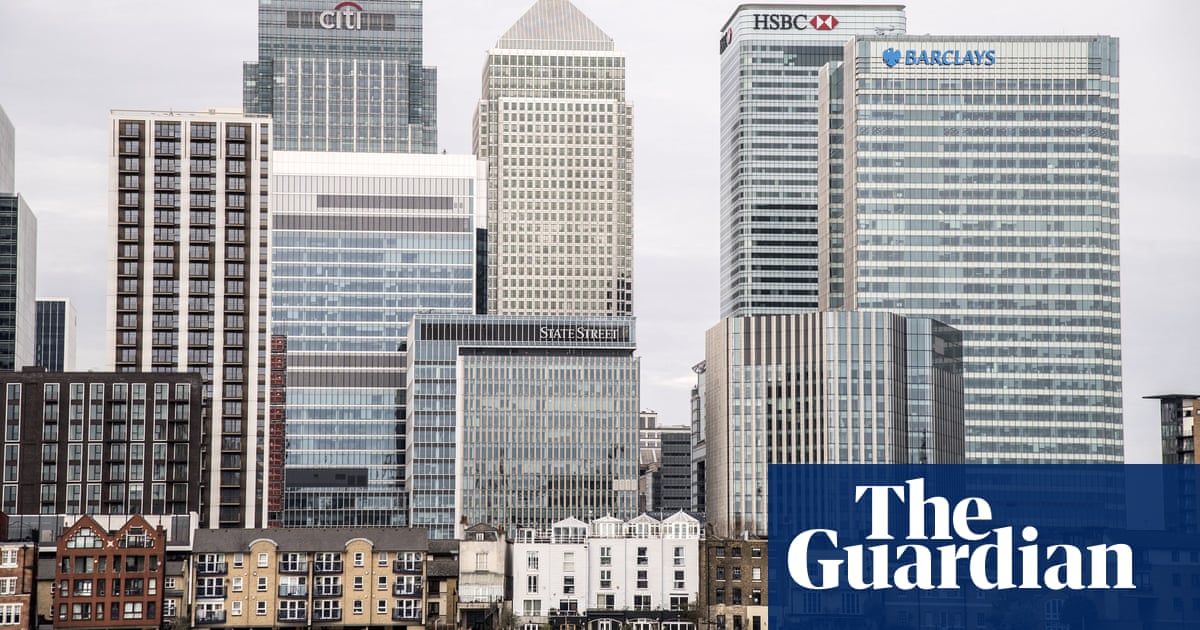
Just over 20 years ago, HSBC moved into its new headquarters in the former docklands area of Canary Wharf in London, a silvery tower designed by the leading architects Foster + Partners that was then the second tallest in Britain. It was a financial factory for 8,500 workers, built with precisely the dimensions and the regularity, as well as what was called a “sophisticated multi-tier lift system”, that were thought essential for one of the world’s biggest banks.
Last week, HSBC announced that, when its lease expires in 2027, it will move back to the City of London, where it was based before the move to Canary Wharf, to offices about half the size of its present ones, described by an industry expert as “smaller, greener, more flexible” and “more convenient”.
It is part of a larger drift, which will also see the giant law firm Clifford Chance move from the wharf to the City.
High among the reasons for this moving and downsizing is the belief that “hybrid working”, the combination of working from home and in an office, is here to stay. Another, linked, factor is that office workers want more from their places of employment when they make their less-frequent visits than they did before – more pleasant environments, more liveliness when they go out on to the streets, more buzz. Taken together, these changes represent small steps forward for civilised living.
Bizarrely, sections of the conservative media have tried to make working from home a battlefield in the culture wars. “The work-from-home fanatics owe us an apology” thundered a recent Daily Telegraph article. But HSBC’s planned move, and data on rail journeys, show that new habits have taken hold. According to Transport for London, commuting levels on Mondays and Fridays are about half of their pre-pandemic levels, and 70% on Tuesdays to Thursdays. Nationwide figures tell a similar story.
People still want to go to offices in the middle of the week, for the informal interchanges it allows with colleagues, but are less likely to make the trip at its beginning and end. If you go to Canary Wharf during rush hour on a Friday morning, it’s not exactly a ghost town but neither does it feel like the throbbing heart of one of the world’s leading financial centres.
The intensity of people exiting its stations, and grabbing breakfast in its many food outlets, has appreciably dropped.
In the rivalry for business between Canary Wharf and the City, which has been going on for more than 30 years, the former could offer efficiency. In the unencumbered spaces of the old docks, its developers could readily build exactly what their occupiers wanted. It was an advantage of the HSBC tower that most of its 45 floors were close to identical so that departments could be shifted from one to another with a minimum of thought. These buildings came in either beige or grey, so as not to compete with the corporate colour of whoever rented the space.
The rap against the wharf has always been that it is dull and lifeless, no matter how hard its management tries to liven things up with open-water swimming and paddleboarding in the former docks, and an array of eating and drinking options. It is beautifully landscaped and well maintained, and its 2,500 security cameras and teams of private guards might make it feel safe, but that’s not enough for many.
“It’s a soulless, horrible place with no character,” one worker there told the Financial Times, notwithstanding her appreciation for the bike storage and onsite gym offered by her company.
The City of London, with its winding medieval streets, couldn’t match the wharf for efficiency, but it had character and diversity of fabric. Not that it was vivacious in the past – it was notorious for the eerie silence of its streets at weekends – but it was close to parts of the capital with spontaneity, richness and surprise.
Its administrators, meanwhile, as part of their ongoing competition with Canary Wharf, have worked hard to animate the place with new restaurants, bars, bookshops and venues.
The result, according to one property professional, is that Canary Wharf is “just being pulverised”. With a number of leases nearing their end, it is vulnerable to what a recent report for the corporation of London called a “flight to quality”.
Its huge buildings, like the warehouses they replaced, are in danger of redundancy – it will be hard to fill the 160,000 square metres that HSBC will vacate.
The wider significance of these changes is that workers for the companies in question will have more choice as to where they live and how they work, spend less time in the drab and polluting business of commuting and more in the places where they live.
They might spend less money in the chain sandwich bars in the cities where they work but more in their local communities. When they do go into office buildings, they will find them more sociable and enjoyable places.
This new world is not for everyone – you can’t clean a hospital floor from home, or fix a boiler or put out a fire. If your home is overcrowded or noisy, you might want to escape to an office at every opportunity.
The truth is that post-Covid work patterns are neither a revolutionary transformation of society nor a woke conspiracy against business and ordinary folk: they are just practical, commonsense arrangements that work for some people and not others. But they are surely progress.












